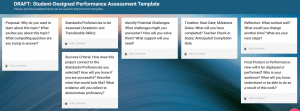Supporting the Development of Student-Designed Performance Assessments
CompetencyWorks Blog
In this final blog post of a four-part series, I provide examples of student-designed performance assessments and strategies for supporting the design process. This work is part of a series of convenings with educational leaders offered by the Vermont Agency of Education to improve personalized, proficiency-based assessment by strengthening local comprehensive assessment systems.
Student-Designed Assessment: Huckleberry Finn
What might a student-designed assessment look like? David Rickert in The Power of Student Designed Rubrics offers an example. Although Rickert provides a “mastery rubric,” students are empowered to develop individual projects to meet identified standards-based expectations:
- Theme: Determine a theme of a text and analyze in detail its development over the course of the text, including how it emerges and is shaped and refined by specific details.
- Support: Cites strong and textual evidence to support analysis of what the text says explicitly as well as inference drawn from the text, including determining where the text leaves matters uncertain.
- Audience: Strong consideration of an audience in project design is evident.
After Rickert shared his initial rubric with students, they are provided the opportunity to develop additional rubric categories related to their specific project and asked to consider the following: skills, quality work, publication, and quantity. This co-developing of a rubric allows students a level of control over how their project will be assessed.
One student, Elli Tai, uses her passion for piano to musically represent various scenes in The Adventure of Huckleberry Finn through a Piano. She describes each scene and then her justification for the music selection. For instance, the South Side Stomp is used to depict Huck as “. . . a lively, free-spirited boy.” She explains, “He loves his freedom, and wants to live adventurously by his—and only his—rules. Huck is miserable while living with Widow Douglas and having to follow her rules (Chapter 1).” Elli then justifies her music choice: “Jazz is a musical style loved for its freedom of expression. This song has an energetic, slightly rowdy tempo, a fun swing style, and thrill-seeking runs.” She not only selected each piece of music, but also learned how to perform the pieces in a professional manner.
This student-designed performance assessment was then reviewed by participants to determine strengths of the assessment as well as potential areas of improvement. A tool, The Student-Led Performance Assessment Review Template from the Virginia Student-Led Assessment Networked Improvement Community, allowed educators to review the assessment by looking for evidence related to:
- Voice and choice;
- The Assessment process and products;
- Students’ goals, self-assessment, and reflection; and
- Feedback opportunities throughout the process.
Although the Huckleberry Finn performance assessment had many positive attributes, some areas for potential improvement were also identified. The goal is to use tools like the Student-Led Assessment Review Template to objectively review student-designed assessments and ensure that these assessments provide evidence of rigorous learning related to standards or proficiencies.
Supporting the Design Process: The Student Assessment Template
In an effort to support the development of student-designed assessments, content specialists at the VT Agency of Education constructed this DRAFT Student-Designed Performance Assessment Template in Padlet (also shown below) so that educators and students can provide feedback to improve the process. It mirrors performance assessment templates created for educators. Additionally, since personalized learning plans are required for all Vermont students in grades seven through twelve (See Act 77), the template intentionally aligns with the critical elements of a Personalized Learning Plan (PLP): student goals, action steps, achievement of action steps, reflection, and revision.

This alignment highlights the connections between the personalized learning planning process, student-designed assessments, and PLPs, because students are designing and assessing their own learning. Some student-designed assessments can be used as both tools for assessment in the classroom and as non-assessed entries in a student’s PLP. As examples of this dual purpose, sample PLPs for the Arts, History, and STEM were used to help clarify connections.
This convening provided an opportunity to share a student-designed assessment template draft with educators and receive feedback regarding the language in the document, the length, and the various components. Our next step will be to work collaboratively with students to get their feedback for revision. The authors of Learning to Improve strongly advise innovators to check with the “users.” Since students are the intended “users” of this document, it is vital that we get their feedback. In the past, when students have been given the opportunity to provide feedback on our work, they have always helped to improve it. Their perspective is extremely valuable.
Closure
At the end of the day, we revisited our initial question: What do you think are the most essential components of student-designed assessments? Participants talked about how student-designed assessments can empower the learner and respect their ability to identify evidence that documents the learning that has taken place. Our hope is that in the near future, we will have examples of Vermont student-designed assessments to share with others.
Learn More
- Essential Components of Local Assessment Systems for Personalized, Proficiency-Based Learning
- Student-Designed Performance Assessments for Personalized Learning and Student Agency
- Improving Student-Centered Assessment Systems With Formative and Summative Performance Assessments
 Pat Fitzsimmons is Proficiency-Based Learning Team Leader at the Vermont Agency of Education. She collaborates with educators to implement proficiency-based learning and assessment systems that are student-centered. She has worked with various stakeholders to construct a Vermont Portrait of a Graduate and co-authored numerous documents related to proficiency-based learning. Before moving to state-level work, Pat was the Science Specialist for the Barre Supervisory Union in Vermont. She also fondly remembers her first fourteen years in public school as a kindergarten teacher. Pat was the first kindergarten teacher in Vermont to receive the Presidential Award for Excellence in Science Education.
Pat Fitzsimmons is Proficiency-Based Learning Team Leader at the Vermont Agency of Education. She collaborates with educators to implement proficiency-based learning and assessment systems that are student-centered. She has worked with various stakeholders to construct a Vermont Portrait of a Graduate and co-authored numerous documents related to proficiency-based learning. Before moving to state-level work, Pat was the Science Specialist for the Barre Supervisory Union in Vermont. She also fondly remembers her first fourteen years in public school as a kindergarten teacher. Pat was the first kindergarten teacher in Vermont to receive the Presidential Award for Excellence in Science Education.